Wednesday, April 4. I didn’t try but my two-plus-hour-easy-cruising soaring flight ended up being the fastest flight in a glider on that day. Fastest as in: highest average speed. Worldwide. That came as a big surprise to me because I hadn’t even thought about it. I had just been flying along – as it turns out at an average speed of almost 152 kilometers per hour (82 kts). Equally surprising is the fact that the 325 kilometer flight was also the 10th longest flight that day. Here are the stats from the Online Contest:
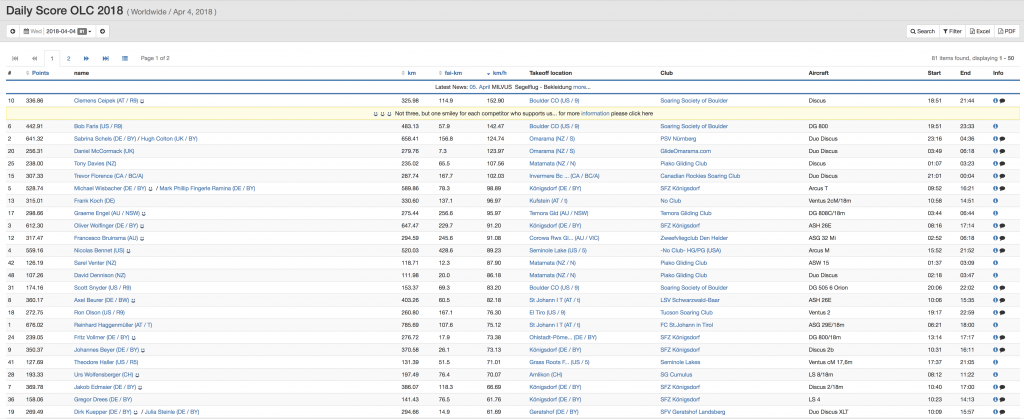
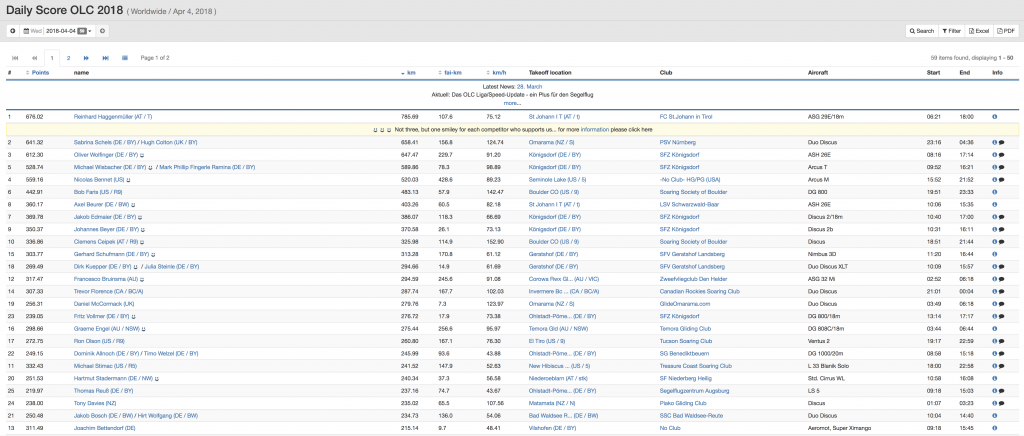
So how did that happen? The answer is easy: strong winds from the west, increasing with altitude, blowing across the Front Range of the Colorado Rocky Mountains. In other words: mountain wave.
Looking at the sky in the morning it wasn’t all that obvious that a strong wave day was afoot. Here’s a short time lapse of the sunrise from our home in the foothills looking east. The wind seems to be coming more from the left, i.e. from the north. The fuzzy edge of the cloud does not look like a lenticularis and you have to look very carefully to spot any indications of rotor activity.
The forecast from Skysight on the other hand looked very confident:
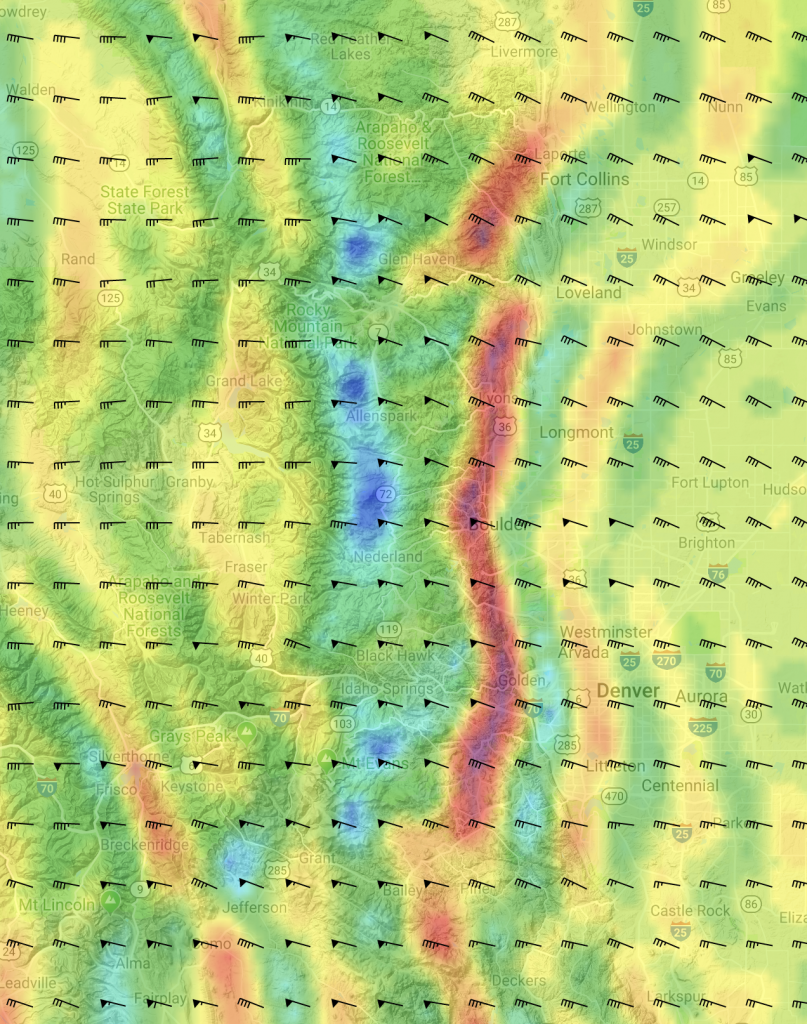
Around noon, however, the wind on the ground was blowing firmly from the east. The sky was overcast due to a layer of high clouds and seemed deceptively calm. The only real indication of wave aloft came from pilots flying into Jefferson County Airport a few miles south of Boulder, who reported moderate to severe turbulence a few thousand feet above ground: just because you can’t see any rotors doesn’t mean that there aren’t any.
Just before 1pm I was ready to launch. The air became turbulent at about 1,000 feet above ground and when I hit the first strong climb at 1,600 AGL I released without hesitation. That turned out to be a mistake. After climbing in very choppy lift to 2,300 AGL I bumped up against a strong wind shear layer that I was unable to get through. After a few attempts in different locations I returned to the airport and decided to take another tow.
This time I asked the tow pilot to take me above the wind shear layer and over the foothills. After a very bumpy ride on tow where I involuntarily practiced several slack line maneuvers I released at 10,400 MSL directly in rotor lift. I had no difficulty to climb to 12,500 MSL where I first encountered laminar airflow and the climb rate improved. Within a few minutes I had ascended above 16,000 feet and from there everything became very easy.
The lift was strong and consistent, the wave bar wide and forgiving. The wind was blowing at about 40 kts but the Discus flies fast and so I could easily cope with the necessary crab angle and make rapid progress relative to the ground. As the air got thinner and thinner the difference between Indicated Airspeed and True Air Speed (and therefore ground speed) increased. The lift was so strong that I had to trim all the way forward and fly at 100-110 kt IAS to avoid climbing above 18,000 feet. At several occasions the lift was so strong I even had to open the spoilers to stay below Class A airspace.
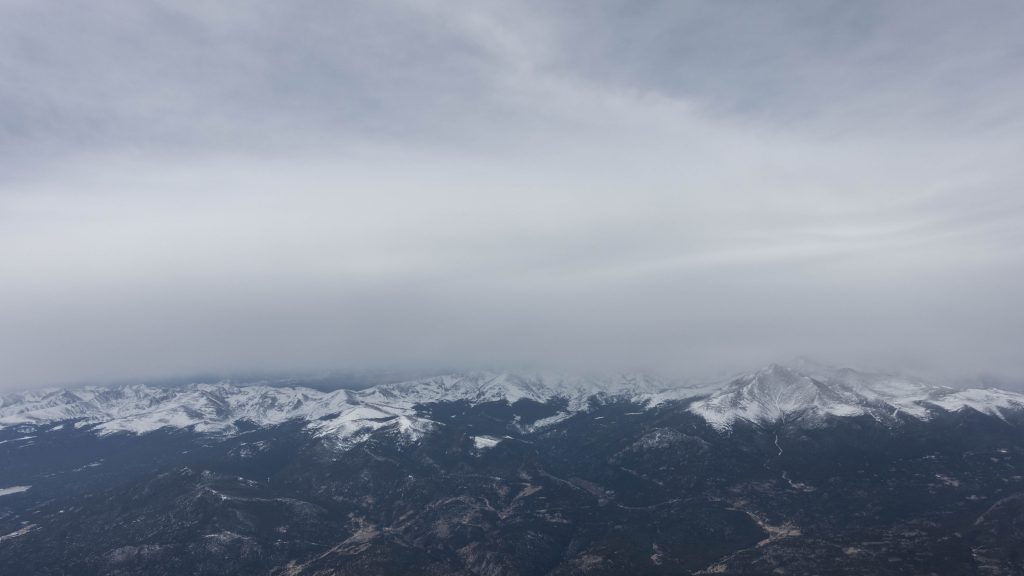
The clouds were only moderately useful to gauge the location of the wave. There was a fuzzy cap cloud along the front range with a Föhn gap between it and the next layer of clouds to the east. However, a high cirrus shield often obscured the position of any lenticular clouds. For most of my flight I navigated by looking at the position of the mountain ranges relative to the direction of the wind, which blew from northwesterly directions.
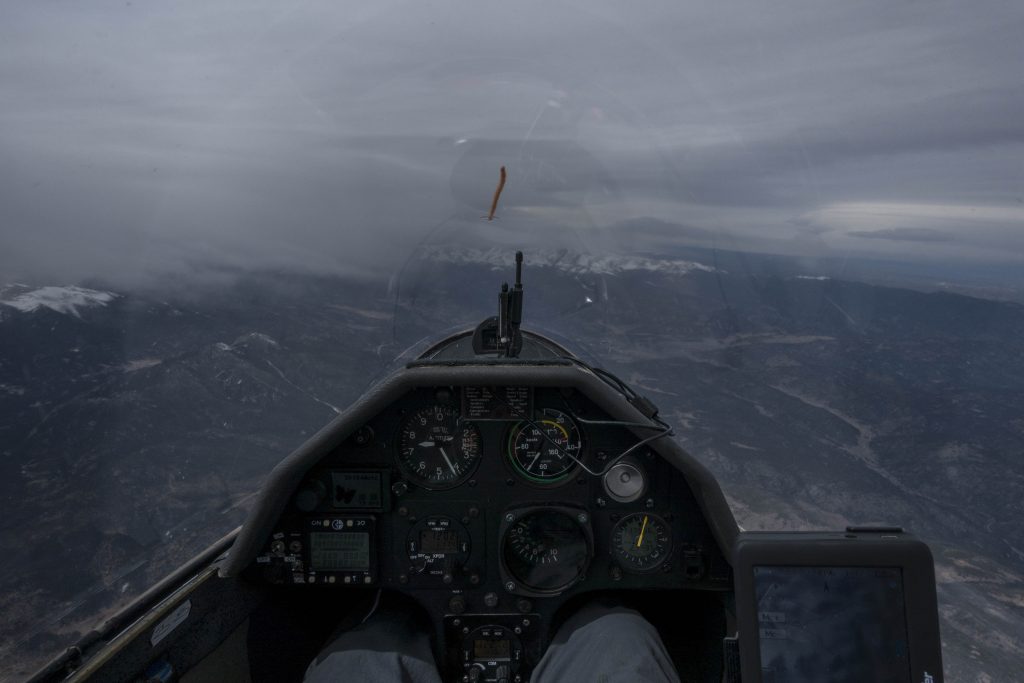
The position of the primary wave was a few miles further west than Skysight had predicted, and the northerly component of the wind was a bit more pronounced, but other than that the forecast turned out to be pretty accurate.
Unlike prior wave flights, I had no difficulty passing Longs Peak and continuing beyond Estes Park to the north. To the south I crossed I-70 until I had a great view of South Park behind Mount Evans to my right. I briefly considered an attempt to fly past Mount Evans but decided to err on the side of caution not knowing where I would land in South Park if things didn’t work as well as I thought they might. (I later learned that Bob Faris, another Boulder pilot flying that day, ventured into the South Park area. He reported that the wave turned violent around Mount Evans and that conditions were much more difficult further south. He dropped below the laminar layer and worked rotor lift and thermals all the way to Fairplay and back. Otherwise his average speed would have been much faster than mine. His flight track is here.)

So I kept cruising back and forth along the Front Range. There was very little effort involved and not much decision making. I enjoyed the scenery and was happy that my transponder was broadcasting my location and altitude so that air traffic control could make sure that no jets would suddenly emerge out of the cap cloud and into my flight path. After about two hours I felt quite cold and decided to return to the airport. There is no doubt that I could have kept yo-yoing along the mountains for several more hours. It was one of my easiest wave flights to date.
The return from laminar airflow into the rotor zone brought me back to the harsher realities of wave flying. I encountered severe turbulence as high as 16,000 feet in the secondary wave and cautiously descended with open dive brakes at a save speed of around 70 kts through some of the most violent wind shear turbulence I had so far experienced. Fortunately I had remembered my lessons from earlier flights and tightened my straps and removed all loose items before starting the descent.
As I got close to the airfield I was surprised that the wind on the ground was still blowing hard from the east. I checked three times to make sure that my mind wasn’t playing tricks on me. There was no turbulence in the pattern and the landing was smooth and easy.
Here’s a link to my flight track.
Post flight: the level of moisture increased later in the day and the position of the wave became much more visible. Here’s a short time lapse of the wave at sunset:
Lessons Learned:
- Wave may be hard to see even if there are clouds in the sky. For most of my flight, the moisture level was too low at the height of most of the wave activity so no clouds formed except for the fuzzy cap cloud over the Front Range and the high cirrus shield above (that probably had little to do with the wave itself.)
- Being fast can be really easy if the conditions are right. I made no attempt to fly fast. My high average speed was simply a function of flying straight in consistently strong lift, even requiring high speeds to avoid climbing above 18,000 feet into Class A airspace, coupled with flying at high altitudes where true air speed is 36% higher than indicated airspeed. So my cruising speed of 100 kts IAS was really 136 kts TAS at 18,000 feet. My average ground speed was “only” 82 kts. A big factor explaining that difference is the crab angle necessary to compensate for the wind drift when flying along a wave bar (when the wind must logically always come from the side).
- Ground speed varies dramatically in strong wind conditions depending on your heading relative to the wind. This is rather obvious and not a “new” lesson. But the stats make it very clear: my flight trace shows that my maximum ground speed was more than 160 kts (considerably faster than the maximum airspeed of the glider) even though I never flew above 110 kts IAS, while my minimum ground speed was below 20 kts (much slower than the minimum air speed of the plane).
- Remember that flutter, and therefore Vne, is a function of TAS, not IAS. Don’t trust the red line on the airspeed indicator to determine how fast you can fly safely at altitude. Fortunately the Discus is built to go fast, even high. According to the flight manual, Vne is 135 kts all the way to 13,000 feet and only then begins to drop off. At 16,400 feet it is still 131 kts and at 19,600 feet it is 124 kts.
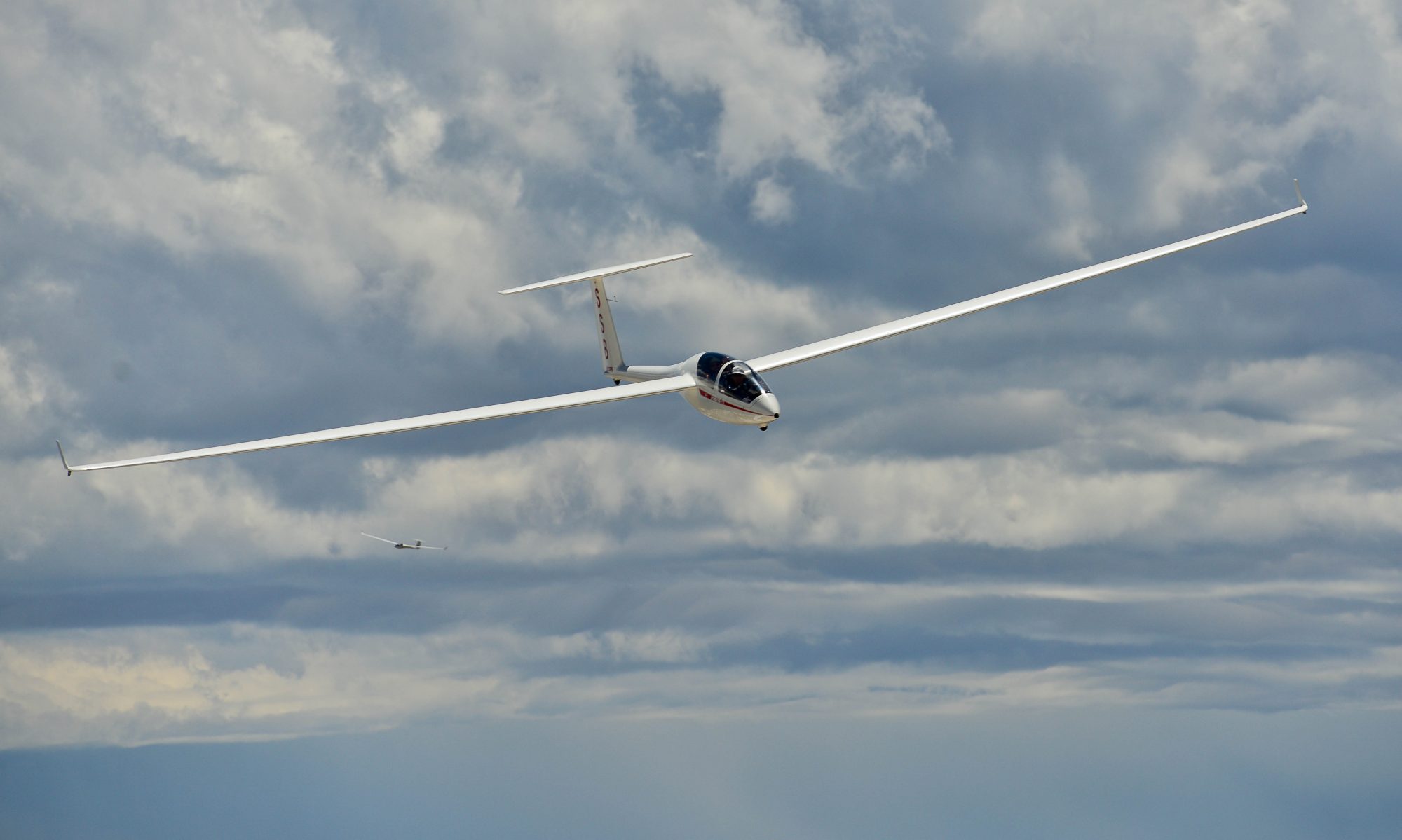

Nice flight Clemens. Very complete description including forecast tools, Online contest and dangers.
What O2 system did you use?
Phil Ecklund
Biamond #115. 1968.
Thanks, Phil! I used the regular EDS system set to kick in at 10k feet. Are you wondering about my comment at the end about tricks of the mind? The oxygen was working just fine during the entire flight 😉